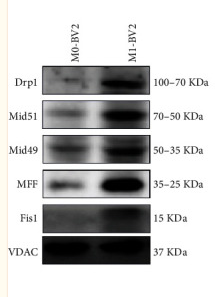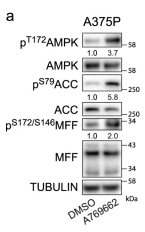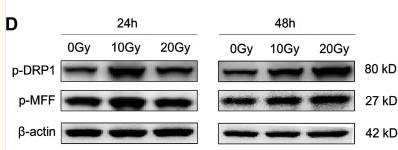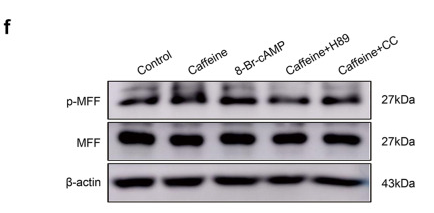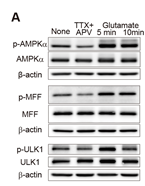Phospho-MFF (Ser172/Ser146) Antibody - #AF2365
| Product: | Phospho-MFF (Ser172/Ser146) Antibody |
| Catalog: | AF2365 |
| Description: | Rabbit polyclonal antibody to Phospho-MFF (Ser172/Ser146) |
| Application: | WB IHC |
| Cited expt.: | WB |
| Reactivity: | Human |
| Prediction: | Rabbit |
| Mol.Wt.: | 25, 27kDa; 38kD(Calculated). |
| Uniprot: | Q9GZY8 |
| RRID: | AB_2845379 |
Related Downloads
Protocols
Product Info
*The optimal dilutions should be determined by the end user. For optimal experimental results, antibody reuse is not recommended.
*Tips:
WB: For western blot detection of denatured protein samples. IHC: For immunohistochemical detection of paraffin sections (IHC-p) or frozen sections (IHC-f) of tissue samples. IF/ICC: For immunofluorescence detection of cell samples. ELISA(peptide): For ELISA detection of antigenic peptide.
Cite Format: Affinity Biosciences Cat# AF2365, RRID:AB_2845379.
Fold/Unfold
C2orf33; Chromosome 2 open reading frame 33; DKFZp666J168; GL004; Mff; MFF_HUMAN; MGC110913; Mitochondrial fission factor; OTTHUMP00000164235;
Immunogens
A synthesized peptide derived from human MFF around the phosphorylation site of Ser172.
- Q9GZY8 MFF_HUMAN:
- Protein BLAST With
- NCBI/
- ExPASy/
- Uniprot
MSKGTSSDTSLGRVSRAAFPSPTAAEMAEISRIQYEMEYTEGISQRMRVPEKLKVAPPNADLEQGFQEGVPNASVIMQVPERIVVAGNNEDVSFSRPADLDLIQSTPFKPLALKTPPRVLTLSERPLDFLDLERPPTTPQNEEIRAVGRLKRERSMSENAVRQNGQLVRNDSLWHRSDSAPRNKISRFQAPISAPEYTVTPSPQQARVCPPHMLPEDGANLSSARGILSLIQSSTRRAYQQILDVLDENRRPVLRGGSAAATSNPHHDNVRYGISNIDTTIEGTSDDLTVVDAASLRRQIIKLNRRLQLLEEENKERAKREMVMYSITVAFWLLNSWLWFRR
Predictions
Score>80(red) has high confidence and is suggested to be used for WB detection. *The prediction model is mainly based on the alignment of immunogen sequences, the results are for reference only, not as the basis of quality assurance.
High(score>80) Medium(80>score>50) Low(score<50) No confidence
Research Backgrounds
Plays a role in mitochondrial and peroxisomal fission. Promotes the recruitment and association of the fission mediator dynamin-related protein 1 (DNM1L) to the mitochondrial surface. May be involved in regulation of synaptic vesicle membrane dynamics by recruitment of DNM1L to clathrin-containing vesicles.
Mitochondrion outer membrane>Single-pass type IV membrane protein. Peroxisome. Cytoplasmic vesicle>Secretory vesicle>Synaptic vesicle.
Highly expressed in heart, kidney, liver, brain, muscle, and stomach.
Belongs to the Tango11 family.
References
Application: WB Species: Human Sample: A375P cells
Application: WB Species: Mouse Sample:
Application: WB Species: Mouse Sample:
Application: WB Species: Rat Sample:
Application: WB Species: Mouse Sample:
Application: WB Species: Mouse Sample: M0-BV2 and M1-BV2 cells
Restrictive clause
Affinity Biosciences tests all products strictly. Citations are provided as a resource for additional applications that have not been validated by Affinity Biosciences. Please choose the appropriate format for each application and consult Materials and Methods sections for additional details about the use of any product in these publications.
For Research Use Only.
Not for use in diagnostic or therapeutic procedures. Not for resale. Not for distribution without written consent. Affinity Biosciences will not be held responsible for patent infringement or other violations that may occur with the use of our products. Affinity Biosciences, Affinity Biosciences Logo and all other trademarks are the property of Affinity Biosciences LTD.



